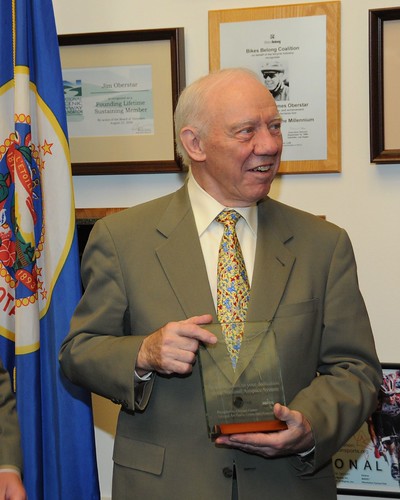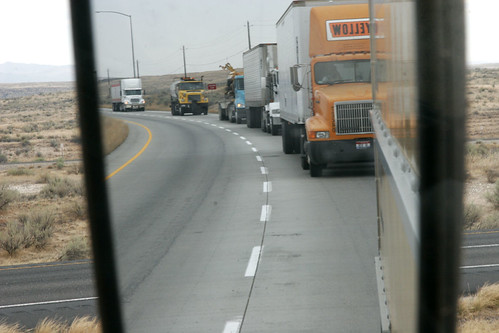After rejecting criticism that it is taking on too much, the Obama administration has identified one area where ambitious reforms will have to wait: overhauling the nation’s aging, congested and carbon-emitting transportation system.
It became clear at a contentious Senate hearing yesterday that the half-trillion-dollar question is how to pay for the bill. The 18.4-cent federal gas tax has not been raised since 1993, and revenue from it falls increasingly short every year because of inflation and the shift to more fuel-efficient cars.
The White House and some of its Senate allies are letting it be known, though, that this is not a discussion they want to have now, in the middle of a recession and as Washington is consumed with battles over health care and energy. Also, polls show that Americans are growing anxious about government spending.
“President Obama does have a vision for transportation. It’s not something he’s going to ignore or turn a blind eye to at all,” Transportation Secretary Ray LaHood told skeptical senators yesterday. “The timing is where we part company.”
Rep. Peter A. DeFazio (D-Ore.) is proposing that if the White House and the Senate will not consider a higher gas tax, then the bill could be paid for with a new tax on oil speculators.
Rep. Elijah E. Cummings (D-Md.) said: “President Obama said to us during the campaign that we must have the fierce urgency of now. And that’s what Mr. Oberstar has done.”
Boxer agreed but said a gas tax increase now is not feasible. “I would tell you if you go out to the people of America and say that’s the solution, I don’t think they will buy it,” she said. “They’re struggling right now.”
Click here to read the entire article.
Green transportation advocates are pressing Congress to refuse any new spending that’s not tied to reform of the existing system — a call that influential senators in both parties ruled out today.
Senate Environment and Public Works Committee Chairman Barbara Boxer (D-CA) joined Sen. Jim Inhofe (OK), the panel’s ranking GOPer, in endorsing another 18 months of the 2005 transportation bill.
The extension, Boxer said, should be “clean as it can be, clean as a whistle … not with these policy changes, because it will in fact jeopardize a quick passage of this extension.”
Boxer’s agreement to an extension free of policy reforms appears to be an acknowledgment that Inhofe and most other GOP senators would slow down approval of the short-term transportation measure. But she faced a lone critic today in Sen. George Voinovich (R-OH), who challenged Boxer to back down from her opposition to raising the federal gas tax during an economic recession.
Voinovich reminded the Californian that she “is always talking about the environment; [drafting a new transportation bill] is going to have a huge impact on greenhouse gas emissions.” He suggested that senators “look at” the House transportation bill offered by Rep. Jim Oberstar (D-MN) and pitch the American public on an increase in the gas tax, which has remained static since 1993.
In fact, recent polling supports Voinovich’s argument, not Boxer’s. A survey released earlier this year by the advocacy group Building America’s Future found that 81 percent of Americans would pay more in federal taxes to support infrastructure investments.
But the alignment of Boxer and Inhofe, as well as Sen. Max Baucus (D-MT) — whose Finance Committee must agree on a revenue source for the next transportation bill — in favor of a clean 18-month extension is enough to doom the House effort to pass a bill this year.
Click here to read the entire story.
Getting business interests to work on methods for funding a long-term transportation bill can help shift the political climate, he told Streetsblog Capitol Hill today after Senate environment committee chairman Barbara Boxer (D-CA) vowed to continue searching for revenue raisers that can pay for massive new legislation.
“Right now, the president is frankly worried about health care, climate change, a lot of other things [and may have said] ‘see, I don’t need another thing on my plate,'” Voinovich said.
But, he added, the White House would likely come around if the private sector — which has “been heretofore reluctant … to step up” — is willing to shoulder some of the extra tax burden needed to pay for increased infrastructure investment.
The senator suggested pushing for a transportation funding extension shorter than 18 months, “to put the pressure on to get this thing done by next year.” In response, Basso would say only that “we’re supportive of the Oberstar [House] bill moving forward.”
Click here to read the entire article.
Congressman Peter DeFazio: Make Wall Street A**holes Foot The Bill For Infrastructure (The Infrastructurist)
Politicians agree that we need to invest in our transportation infrastructure, but ask any of them how we should pay for it and you’re likely to endure an uncomfortable silence. The problem is so bad that it seems to have derailed the new transportation bill until 2011.
There is at least one guy willing to offer a serious proposal though. Instead of taxing drivers more at the pump, says Peter DeFazio, why not make those finance guys that we all hate so much pay for it?
Specifically, the Democratic congressman from Oregon wants to impose a small tax–0.02%–on oil futures contracts.
From his office: “A transaction tax on crude oil securities will close the gap in funding a twenty-first century transportation system while lowering the price of oil. This is a win/win,” DeFazio said. “If we put off this transportation authorization, we will push off needed reform. Every day we wait people will sit in traffic instead of spending time with their families, every day people are not as safe as they could be because of our crumbling infrastructure, every day our economy suffers when our products sit in traffic jams. My proposal will not cost consumers one cent but will substantially increase our investment in our transportation infrastructure.”
The only trick will be selling it. That shouldn’t be hard with the right name. “The Oil Speculator Tax,” perhaps?
*We’re using “Wall Street” generically here, btw — a lot of oil trading occurs on Chicago Mercantile
Click here to read the entire article.
Today at a hearing on the reauthorization of the transportation bill, Senator Barbara Boxer (D-CA) made it quite clear that Congressman James Oberstar’s (D-MN) proposed legislation won’t make it through the Senate over the next few months. Ms. Boxer’s testimony indicated that she’d push for a no-changes “clean” extension of SAFETEA-LU over the next 18 months, as proposed by Secretary of Transportation of Ray LaHood. More serious reforms will have to wait. This means fewer than hoped for funds for transit and high-speed rail, as well as no substantive improvements in the manner in which federal dollars are distributed.
Congress’ problems are two fold: it has too many other projects on the near horizon and it has no consensus, even along partisan lines, on how to fund a major expansion in transportation funding. Today’s fuel tax, which provides the primary source of revenue for the Trust Fund, is out of cash and cannot fund the nation’s transportation needs alone. A relatively simple extension of SAFETEA-LU, bolstered by an infusion of general fund dollars into the Highway Trust Fund, is the easiest answer.
Mr. Oberstar has been adamant in his desire to push forward the next transportation bill now, but this hearing made clear that the Senate is not going to play along. Ms. Boxer is chair of the Committee on Environment and Public Works, and her position will effectively block Mr. Oberstar’s bill even if that legislation passes in the House. Without the support of the White House, Mr. Oberstar is loosing ground. His inability to pinpoint a stable funding source is similarly problematic.
What hasn’t been suggested, but that which I will continue to bring up, is a simple abandonment of the idea that transportation must be sponsored by its “users.” We are all beneficiaries of a strong transportation network, and filling the Trust Fund mostly with general fund sources is a viable and long-term solution that would require none of the shenanigans that currently deteriorate efforts to raise the gas tax or impose a VMT. Whether now or in 18 months, we’re going to need something better than today’s non-proposals from Ms. Boxer.
Click here to read the entire article.
Over the past week or so, there has been a pretend drama in Washington about whether we’ll be getting a giant new transportation bill in 2009. The prospect is exiciting, of course, because in addition to $500 billion in loot that would be handed out, the bill would offers tantalizing opportunities for bureaucratic and policy reform.
On Monday, perhaps the most active and powerful Congressional player in these matters, Jim Oberstar, released his long-awaited draft version of the bill and, along with his committee-mates, vowed to push forward and get it passed into law by the end of September.
Oddly, that came on the heels of the Secretary of Transportation–a man who speaks for the president–requesting that it be kicked back to 2011 and that Congress craft an 18 month extension of the present legislation to cover the country’s needs in the meantime. Clash of the titans?
Now, at a hearing today in the Senate, Barbara Boxer pretty much closed the door on the idea the bill might happen this year. As chair of the Environment and Public Works committee, she would play a leading role in sheparding the bill through the upper house. And she’s saying unequivocally that the new bill will have to wait for 2011.
She gave a very clear reason: “It’s not because we [in the Senate] have a full plate”–dealing with healthcare, climate, and financial reforms–”it’s because we have no consensus on how to fund the new bill.”
“Oberstar wants to raise the gas tax,” she said, then noted it would have to go up by a dime just meet the current shortfall in the Highway Trust Fund. She took a spin through the math of how much it would have to go up to cover the new investment he proposed in the bill. And while she neither she or her witnesses stated an exact figure, it would probably be 25 cents or so more. (The tax now stands at 18 cents per gallon.)
Click here to read the entire article.
The executive director of an influential group representing top transportation officials from around the country told a Greater Baltimore Committee summit Thursday that it is time for the United States to “grow up” and increase the federal tax on gasoline and other motor fuels.
John Horsley, executive director of the American Association of State Highway and Transportation Officials, warned that without new revenue, the U.S. transportation infrastructure faces a grim future.
“We’re in the soup,” Horsley warned the gathering of Baltimore business leaders, transportation officials and civic activists.
Horsley, whose organization represents state transportation secretaries and other top officials, noted that the 18.4 cents per gallon federal gas tax has remained level since the early 1990s and that the national highway trust fund is heading for depletion in August.
Horsley noted that two recent bipartisan commissions created by Congress concluded that federal fuel taxes must increase. One backed a rise of 25 to 40 cents; the other urged an increase of 10 cents a gallon on gasoline and 15 cents on diesel.
Those recommendations were opposed by the Bush administration, and President Barack Obama has ruled out any increase in gas taxes during the recession.
But Horsley said Thursday that a 10-cent increase in the gas tax amounts to “less than 60 bucks” a year for the typical driver.
Without new revenue, Horsley said, Congress must transfer $5 billion to $7 billion to replenish the highway trust fund during the current fiscal year or watch as road projects grind to a halt. He said $8 billion to $10 billion would be needed for the fiscal year that begins in October.
Obama and others have called for passage of an 18-month stopgap funding measure, saying that Congress has its plate full with health care, energy and other issues.
Click here to read the entire article.
The proposed transportation bill calls for $450 billion in federal funding, which is a 57 percent increase over the $286.5 billion bill approved in 2005.
The following is an interview with Rep. John Mica (R., FL), ranking minority member of the House Transportation and Infrastructure Committee, about the recent developments of the transportation bill:
BLUEPRINT AMERICA: The current highway authorization expires at the end of September. So what exactly is expiring?
REP. JOHN MICA: Every six years Congress adopts a federal authorization for highways, which outlines transportation policy, projects, and funding distributions for the whole country.
BLUEPRINT AMERICA: Right now, however, the Obama Administration wants to delay authorization.
REP. MICA: We’re on the verge of a transportation meltdown. The Administration has proposed an 18-month extension of both the highway authorization bill and the highway trust fund. That will require, depending on how long it is extended, between $8 and $15 billion.
BLUEPRINT AMERICA: But, typically, the transportation bill is not authorized every six years – it’s generally extended.
REP. MICA: Right. I think the last time we tried to authorize it we had 13 extensions.
BLUEPRINT AMERICA: Are you opposed to this 18-month extension by the Obama Administration?
REP. MICA: Well, I think that it would be better to go ahead with the transportation bill Rep. (Jim) Oberstar has introduced. We have been working on the bill for some time.
Still, I think we take that bill as the starter. The problem you’ve got with an 18-month extension is that it puts many of the major infrastructure projects on hold. The 18-month extension is a job killer. It gives you a temporary relief with the highway trust fund, but because you don’t have projects approved and policy and funding mechanisms in place for the future, it ends up killing jobs and delaying decisions on projects across the country. For example, there are 6, 800 project requests in the House bill alone – all of these would go on hold.
Click here to read the entire interview.










